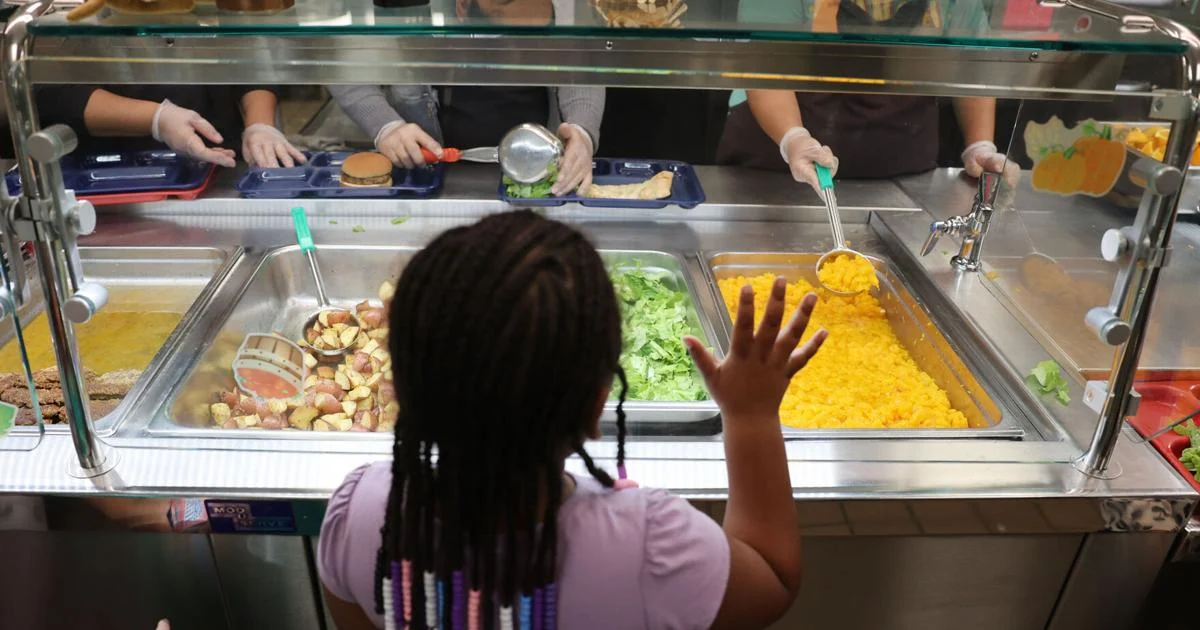
Lenzy Krehbiel-Burton
Tulsa World Reporter
Get email notifications on {{subject}} daily!
Your notification has been saved.
There was a problem saving your notification.
{{description}}
Email notifications are only sent once a day, and only if there are new matching items.
Followed notifications
Please log in to use this feature
Log In
Don’t have an account? Sign Up Today
Stephen Pingry
Tulsa World Photojournalist
Get email notifications on {{subject}} daily!
Your notification has been saved.
There was a problem saving your notification.
{{description}}
Email notifications are only sent once a day, and only if there are new matching items.
Followed notifications
Please log in to use this feature
Log In
Don’t have an account? Sign Up Today
About a month into the school year, several Tulsa-area districts said they are seeing brisk response rates from families on free and reduced-price school meal applications.
“Our numbers are looking really good this year,” Union Public Schools Director of Child Nutrition Bradyn Powell said. “We don’t finalize those until October, but our percentage of students qualifying for free and reduced is higher than last year.”
The U.S. Department of Agriculture authorizes eligibility for free school meals if a child’s family’s income is up to 130% of the federal poverty line or for reduced-price school meals if the family’s income is up to 185% of the federal poverty line.
Effective July 1, for a family of four, that means an annual income of no more than $59,478 for a child to be eligible for reduced-price school meals, or $41,795 for free school meals.
To receive that benefit, families have to fill out an application annually unless they already participate in certain public assistance programs that are part of a data-matching process. Children in the foster care system or whose families receive benefits through Medicaid, SNAP, Temporary Assistance for Needy Families or the Food Distribution Program on Indian Reservations are eligible via a process known as direct certification.
In 2024-25, 76.91% of Union students districtwide qualified for free or reduced-price school meals.
Powell said this year’s numbers might still fluctuate some, with her staff at Union actively contacting families who qualified in previous years and bringing in additional help to prevent eligible students from falling through the cracks.
“We’re hoping that we can get those last few to reapply,” she said. “We’ve had some principals helping us by reaching out directly.”
USDA policy does allow for previously eligible students to continue to receive free or reduced-price school meals for up to 30 days at the beginning of the school year until their family turns in an application and their continued eligibility is confirmed for the new school year.
Powell’s counterpart at Owasso Public Schools, Jon Beckloff, said the number of Owasso students relying on that carryover window had dropped by about 1,200 as of Tuesday compared to one year ago.
“I still have about 300 families who need to reapply, but that is a substantial decrease,” he said.
According to the U.S. Department of Agriculture, school districts’ child nutrition programs in Oklahoma and the 47 other contiguous states will be reimbursed anywhere from $0.40 to $4.86 per meal served during the 2025-26 school year, depending on the meal in question and whether the children served are from households that qualify for free or reduced-price school meals.
Keeping options open to help students
Despite having no legal authority to mandate that local funds be spent on free meals for students who are ineligible for free or reduced-rate school meals, State Superintendent Ryan Walters in early July issued a demand for school districts to do just that and launched a petition drive on the State Department of Education’s website to garner public support.
Even with that announcement, Beckloff said most of the questions his team gets are related to data sharing — or whether a student accepting a free school meal would take away funds from someone else — rather than why a student isn’t getting fed for free.
By law, information shared on a free and reduced-price school meal application is kept confidential.
“You’re not taking away anything from anyone by eating a school lunch,” Beckloff said. “The child nutrition department is unique in that we’re self-funded. The revenue from a student eating a meal with us is how we’re able to pay for our staff, our ovens and other expenses.”
There are mechanisms in place to allow all students at a school to eat for free. The USDA’s Community Eligibility Provision allows all students at a school, district or group of schools to eat for free if enough pupils are eligible for other income-based assistance programs, such as Medicaid, the Supplemental Nutrition Assistance Program or the Food Distribution Program on Indian Reservations.
Instead of requiring families to fill out individual applications for free or reduced-price meals, schools and districts utilizing the CEP receive federal child nutrition funding based on a formula that relies on the number of students whose families participate in at least one other income-based assistance program, are homeless or are part of the foster care system. Any gaps in the cost of offering meals to all students have to be filled in by local funding sources.
Tulsa Public Schools is among area districts utilizing the CEP this year; however, its back to school form for all students includes questions that appear on the free and reduced-price school meal application to help continue offering that option.
Sand Springs Public Schools utilized the CEP in 2024-25 but did not have enough student participation to be able to afford to do so in 2025-26, prompting the district to start notifying families in July that they would need to fill the form out this year to keep receiving school meals for free or at a lower price.
Sand Springs Director of Child Nutrition Sherry Pearson said her staff has had to explain to some families why the district is no longer able to offer free meals to all students, but those conversations have been few and far between.
“Our families have been very understanding for the most part and have been thankful that we were able to do it for that one year,” she said. “If things change and our legislators are able to do something more for our program, … maybe we can qualify again at some point.”
Pearson said Sand Springs’ decision to not participate in the CEP this year has also prompted renewed outreach from area organizations about how to contribute to the district’s unpaid student meal debt fund.
“Those are conversations we’re having, too,” she said. “We’ll be talking with our principals and teachers as the semester goes on. If there’s a kiddo who is collecting charges and they know that there’s a need, we’ll do what we can to help them.
“We’ll look at those specific possible needs and try to help our families the best we can.”
In addition to determining student eligibility, free and reduced-price school meal applications are also used to help calculate how much federal aid is awarded to individual schools and districts under Title I of the Elementary and Secondary Education Act.
Title I provides additional financial resources for schools with a large population of low-income students. Schools in which children from low-income families make up at least 40% of enrollment are eligible to use Title I funds to operate schoolwide programs that serve all children in the school to raise the achievement of the lowest-achieving students.
“It’s not just free and reduced-price meals,” Powell said. “Filling out that application is not just important for families, but it’s important for districts, as well.”
lenzy.krehbiel-burton@tulsaworld.com
Want to see more like this?
Get our local education coverage delivered directly to your inbox.
* I understand and agree that registration on or use of this site constitutes agreement to its user agreement and privacy policy.
Lenzy Krehbiel-Burton
Tulsa World Reporter
Get email notifications on {{subject}} daily!
Your notification has been saved.
There was a problem saving your notification.
{{description}}
Email notifications are only sent once a day, and only if there are new matching items.
Followed notifications
Please log in to use this feature
Log In
Don’t have an account? Sign Up Today
Stephen Pingry
Tulsa World Photojournalist
Get email notifications on {{subject}} daily!
Your notification has been saved.
There was a problem saving your notification.
{{description}}
Email notifications are only sent once a day, and only if there are new matching items.
Followed notifications
Please log in to use this feature
Log In
Don’t have an account? Sign Up Today



